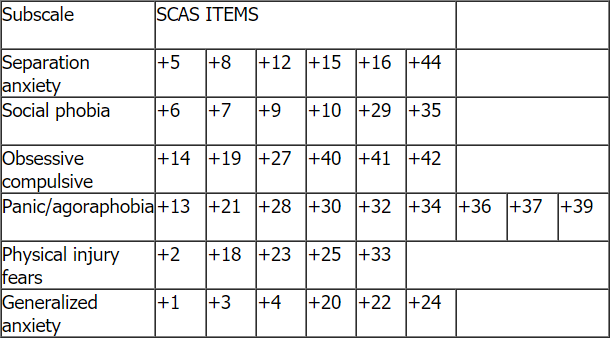Because the font sizes and layout tends to change when printed out from different computers a fixed scoring template is not provided. These may be developed by the practitioner using a plain acetate sheet to overlay on top of the printed survey to assist in scoring.
Alternatively scores 0 to 3 may be entered into a spread sheet for computing purposes.
The following SPSS code may be useful:-
COMPUTE totalscas =SUM(scas1,scas2,scas3,scas4,scas5,scas6,scas7,scas8,
scas9,scas10,scas12,scas13,scas14,scas15,scas16,scas18,scas19,scas20,
scas21,scas22,scas23,scas24,scas25,scas27,scas28,scas29,scas30,scas32,scas33,
scas34,scas35,scas36,scas37,scas39,scas40,scas41,scas42,scas44).
EXECUTE.
COMPUTE scassep = SUM(scas5,scas8,scas12,scas15,scas16,scas44) .
COMPUTE scassoc = SUM(scas6,scas7,scas9,scas10,scas29,scas35) .
COMPUTE scasocd = SUM(scas14,scas19,scas27,scas40,scas41,scas42) .
COMPUTE scaspanicag =SUM(scas13,scas21,scas28,scas30,scas32,scas34,scas36,scas37,scas39) .
COMPUTE scasphysinj = SUM(scas2,scas18,scas23,scas25,scas33) .
COMPUTE scasgad = SUM(scas1,scas3,scas4,scas20,scas22,scas24) .
EXECUTE.
